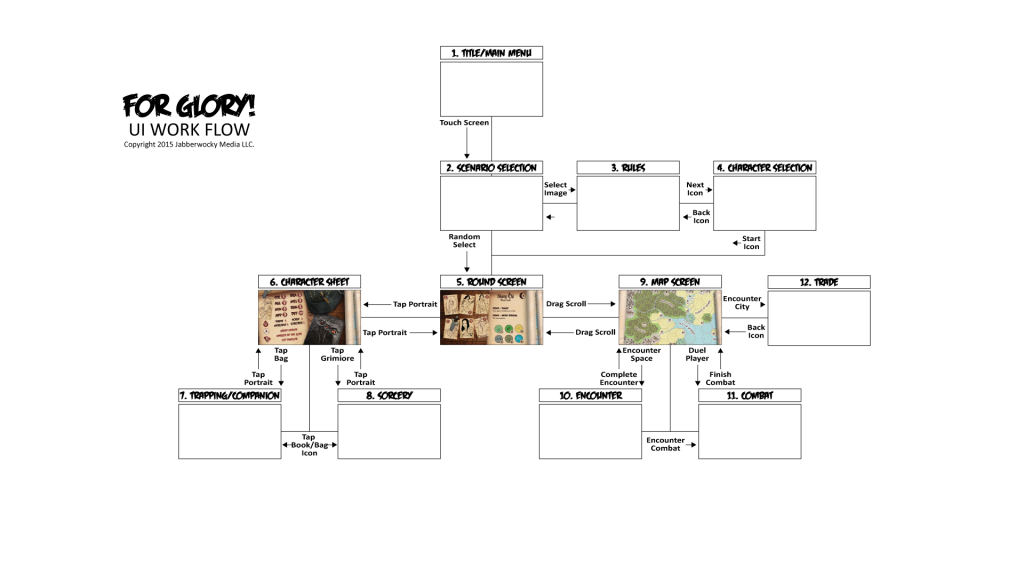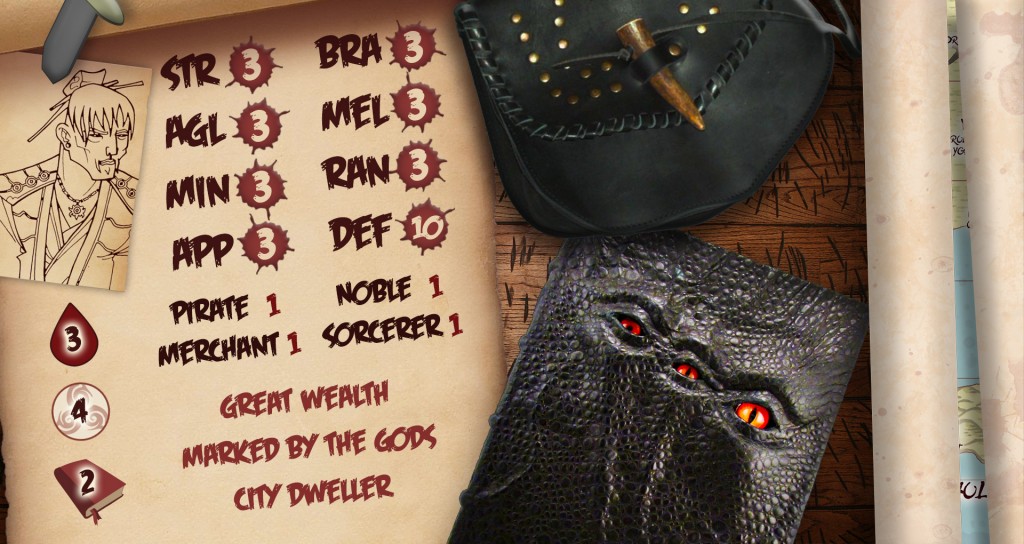It’s been snowing like crazy over here, so I’ve had lots of time to work on the card prototypes for Barbarians of Heavy Metal: Titans. For this Metalworks, I want to show you how things are coming along in that area, and discuss a few of the mechanics in play.
VARIETY IS THE SPICE OF BATTLE
There are a number of card types in BoHM:Titans. It is a Tactical Card game and that means that, as a card representation of a tabletop miniature wargame, it needs a good deal of variety to represent the many wrinkles in that game medium as well as to provide plenty of options for deck customization.
To that end, Titans contains three broad categories of cards, some of which are further divided into specific sub-types. It may seem like a lot of things to remember, but like Magic, a lot of the differences are not necessarily about mechanical sub-systems, so much as a way to organize and target specific types of activity. For example, there is little difference between a Leader card (special in-game personalities) and any other Strategic card in the TAC deck, but there are cards (like the Hashashin) that specifically target Leaders, which means they need a specific icon to represent them, but not an entirely unique rules subset.
The three categories of cards are Titan Cards, System Cards and TAC cards.
TITAN CARDS
Titan cards represent the actual physical structure of the Titan and the Rider behind its control interface. The primary card sub-type in this category are the Superstructure cards, which are laid in a pattern to thematically represent a diagnostic interface, like so:
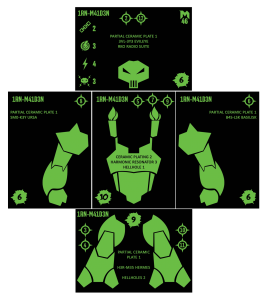
Superstructure cards are unique to each Titan (and will eventually have unique art for said Titan). Each card represents a specific targetable body part with information pertaining to that specific Titan on it, including the Production ID (the Titan’s name), Hit Location numbers, Damage capacity, Systems loadout and, on the head, the game stats and cost (in Metalocity) of the Titan.
When a particular part of the Superstructure takes damage in excess of its Damage Capacity, you flip the card, which then shows you the effect of losing that bit of the Titan (in a nice, bright, alarming red):
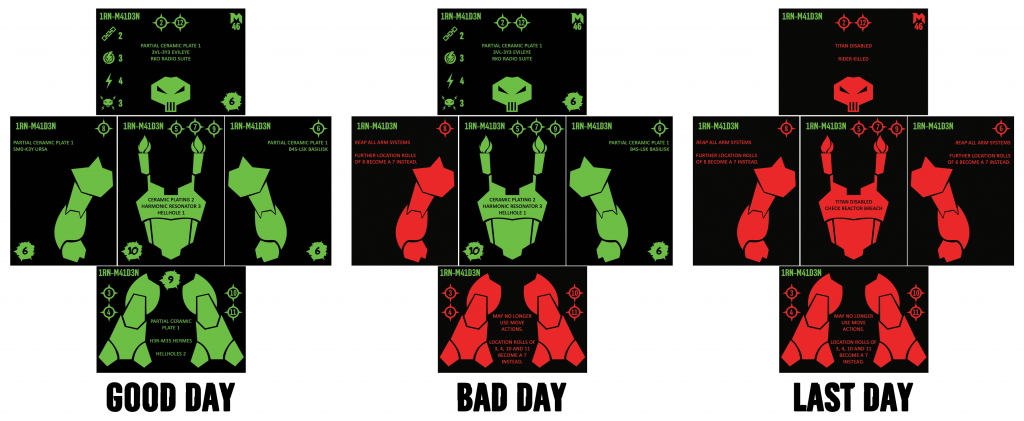
A Titan is only as good as its pilot, however, so the next most important card in this category is the Rider Card, and that is what we will examine next.
I should point out at this juncture that, while most of the graphic design you see on these cards (including icons, backgrounds, etc.) is all my original art, the portrait style images you are going to see from this point on were scoured from the internet for prototyping purposes.The cool image of Bruce Dickinson on the cards below, for example, is borrowed without permission from Ian Jones, although I might commission it and some other work from him for the game if I get enough funding. Check his stuff out, it is really cool.
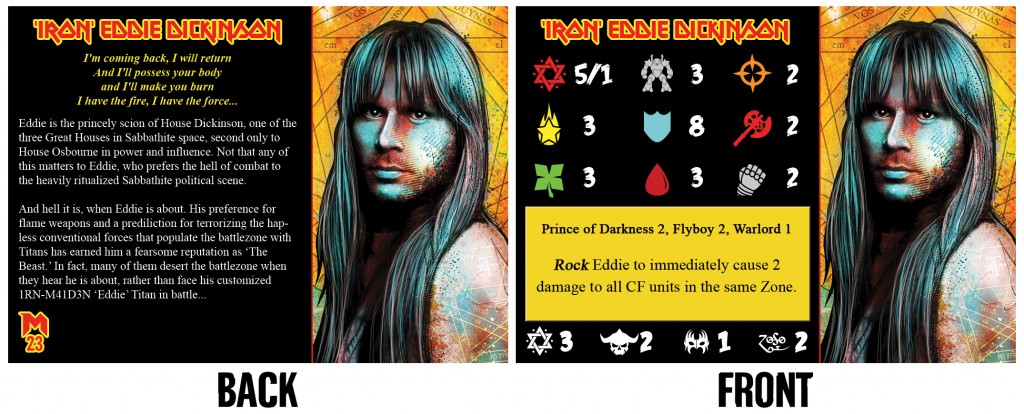
On the back side of the card we have the bio information and cost in Metalocity for our rider. On the front, all the game info needed to use him, including (from left to right) his School of Rock (with Harmonic and Discord numbers), Ride, Fire, Fame, Defense, Shred (melee), Luck, Health, and Rumble (hand to hand) stats.
Below that, in the text box, we have Eddie’s Skill set (which can enhance certain TAC Cards) followed by a special rule that sets him (a veteran) apart from lesser metalheads on the battlefield. In this case, he can cause damage to conventional forces, which represents his fearsome reputation causing mass desertion among the ranks.
At the very bottom we have the various musical styles Eddie is proficient in, which determines which Sonic Wizardry Cards he might include in his TAC Deck.
The third card in the deck is a Target Card, which bears an image of the Titan and serves as a ‘miniature’ on the Tactical Display(which I’ll discuss in an upcoming post).
SYSTEM CARDS
The systems listed on the Superstructure Cards are represented by special System Cards which detail their capabilities and state of readiness.
These cards are set up in the center of the player’s area and are typically activated by ‘Rocking’ them (turning them sideways). After they are Rocked, they must be ‘Readied’ in a later phase. Cards can also be ‘Reaped,’ or removed from the play area and placed in a Salvage Pile. Certain weapons with ammo restrictions might also be ‘Flipped’ over on their face to represent that they are still functional, but out of ammo (Rock/Ready and Reap 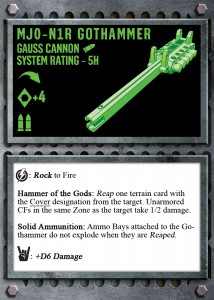 are the main ways you utilize cards in the game and should be familiar to those who have played similar games before).
are the main ways you utilize cards in the game and should be familiar to those who have played similar games before).
The Gothammer on the right, is a Ballistic weapon (indicated by the tilted bullet which means that it can be targeted by certain TAC cards, like the Weapons Jam Discord), it takes up 5 component spaces on the Titan and is High Tech (tech levels, again, allowing targeting of special cards, like Repair, and so on). It has indirect fire, which means it can hit any zone on the Tactical Display, does D8+4 damage and has an Ammo Check rating of 2 (any roll of doubles of 2 or more flips the weapon).
The special rules make each system unique, so no two weapons need be alike. Our Gauss cannon, for instance must be powered to fire (which generates heat), and does extra damage to the surrounding area when it hits. The little hand rocking out at the bottom indicates that this card has a Hardcore result, for those who roll a Harmonic when using it (which, again, I’ll discuss at a later time).
TAC CARDS
The most numerous and variable cards in the game are the TAC cards which make up the TAC deck. Each player may hold a number of cards in their hand equal to 5 + their Rider’s Ride stat.
TAC cards can be Rocked, Readied and Reaped, but also Rolled, i.e. placed at the bottom of the TAC Deck, instead of Reaped, if the card so indicates. They come in a wide variety.
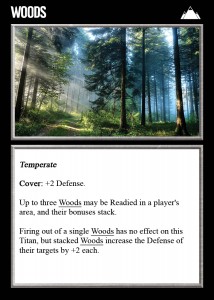 Terrain Cards represent the surface features of the battlefield and how it affects the combatants.
Terrain Cards represent the surface features of the battlefield and how it affects the combatants.
You may play Terrain Cards as a Move Action, which represents your Titan moving into that Terrain, and you might have a number of such actions which means you can layer Terrain cards on top of one another to increase their effect. The number and type of Terrain you can include is determined by the Mission Environment, so these Woods can only be used when said environment is Temperate, for example.
Titans retain the advantages of these cards until they leave a Zone, at which point all terrain cards are Rolled back into the TAC Deck.
Support Cards represent conventional forces, artillery and other battlefield support elements. It is here that you find you infantry, tanks, aerospace forces, and so on, and there are a few special subtypes within this category. Almost all of them require a Support Test, based on the Rider’s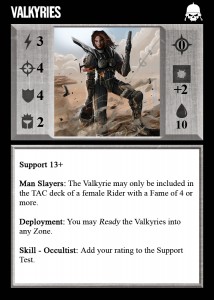 Fame, to Ready into play, representing the scarcity of resources and the fact that only the most famous metalheads will have access to the choicest support units, like the F-Bomb or the Valkyries (seen at right).
Fame, to Ready into play, representing the scarcity of resources and the fact that only the most famous metalheads will have access to the choicest support units, like the F-Bomb or the Valkyries (seen at right).
The Valkyries, for example, are a type of CF, or conventional Forces card (infantry, in particular, as indicated by the top right icon). These are played onto the Tactical Display and function like Titans, with 1 action each Game Round (called a Clash).
They have their own limited set of stats, like movement speed, Fire, Defense and Armor, as well as a set range, damage type (D6+2 in the Valkyries case) and Damage Capacity. Elite units will have other special rules.
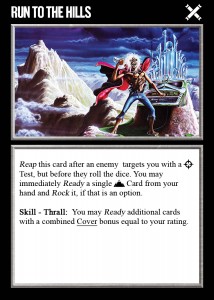 Tactical Cards (indicated by the barricade icon in the top right) represent certain advantages that might present themselves during the course of battle, like an opportunity to push an enemy of the side of a cliff, or special tactics a rider might regularly use, like powering down to hide their Titan.
Tactical Cards (indicated by the barricade icon in the top right) represent certain advantages that might present themselves during the course of battle, like an opportunity to push an enemy of the side of a cliff, or special tactics a rider might regularly use, like powering down to hide their Titan.
A Rider’s skills are often important components when determining the effectiveness of certain Tactical Cards. Just because two different players have the Run for the Hills card in their Deck, it is the one whose Rider has the Thrall skill that will find it most useful, playing more and/or better cards as instants than the Rider who was never a slave in the Metalsphere.
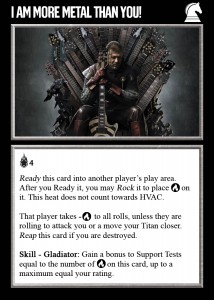 Strategic Cards are like Tactical cards, but on a grand scale. They represent the effects of long term planning before the battle and have a much longer-lasting and widespread effect than Tactical cards, which are all based on spur of the moment decision making.
Strategic Cards are like Tactical cards, but on a grand scale. They represent the effects of long term planning before the battle and have a much longer-lasting and widespread effect than Tactical cards, which are all based on spur of the moment decision making.
Like Support cards Strategic Cards really rely on your reputation to use effectively. You may never use a Strategy card that has a Fame requirement (represented by the flaming star icon) higher than your Rider’s Fame. For instance, I Am More Metal Than You, represents the Titan Rider challenging another Rider’s Metalocity, and that only works when you are plenty Metal yourself.
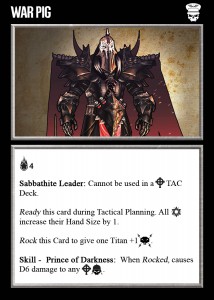 A sub-type of Strategic card is the Leader (represented by the skull icon wearing an officer hat). These cards represent special personalities in your Warzone that you might have influence with. If you have the ear of a Leader, they can use their influence to provide everyone on your side of the battle with long term enhancements.
A sub-type of Strategic card is the Leader (represented by the skull icon wearing an officer hat). These cards represent special personalities in your Warzone that you might have influence with. If you have the ear of a Leader, they can use their influence to provide everyone on your side of the battle with long term enhancements.
While there are generic personalities, like Hashashin (assassins) and Shades (scouts), most leaders, like the War Pig, are very particular to a certain School of Rock, and may only be used by a Rider from that School. This often have negative effects on Riders from the opposing School as well, as the War Pig does on Nazarite Infantry.
 Harmonics are special cards that you can play when you roll your Schools sacred number on the Rocktohedron (the eight sided die). They come in two types: generic, like the Scream card to the left, which can be played by anyone; and School Specific, which can only be included in a deck of a Rider from that specific School of Rock.
Harmonics are special cards that you can play when you roll your Schools sacred number on the Rocktohedron (the eight sided die). They come in two types: generic, like the Scream card to the left, which can be played by anyone; and School Specific, which can only be included in a deck of a Rider from that specific School of Rock.
These cards are used to really push the uncertainty of combat, where a bit of luck is always a factor and special circumstances can swing the tide of battle in truly bizarre directions, like ripping another Titan’s arm off and beating it with its own appendage. Some Harmonics are Reaped immediately, but some stay in play until Reaped by Discord.
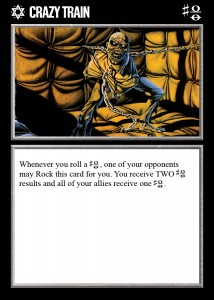 Discords (represented by the Augmented Fourth Icon) are the opposite of Harmonics, and you actually don’t play these on yourself, but on other players who roll the number of the opposing school on their Rocktohedron.
Discords (represented by the Augmented Fourth Icon) are the opposite of Harmonics, and you actually don’t play these on yourself, but on other players who roll the number of the opposing school on their Rocktohedron.
You play Discords directly into another player’s area, and they hang about causing problems until that player can Reap them with a Harmonic or special card.
They come in general and specific flavors, but you really want to stack your deck with Discords that affect a specific School (represented by the icon to the Left of the title) to get the most use out of them, which means keeping a side board with Discord cards for various schools handy.
 Overheat Cards are part of the Heat system in the game. Generating excess heat shuts down systems as it rises, but it also leaves the Titan open to having one of these cards played on it by another player during the HVAC phase if the heat level equals or exceeds the rating on this card.
Overheat Cards are part of the Heat system in the game. Generating excess heat shuts down systems as it rises, but it also leaves the Titan open to having one of these cards played on it by another player during the HVAC phase if the heat level equals or exceeds the rating on this card.
Overheat cards allow me to implement a wide variety of funky heat effects that can hamper, damage or even disable a Titan. The Ammo Explosion card on the left, for instance, reaps an Ammo Bay, which (based on the info on the Ammo Bay card) causes it to explode and damage the Titan. There are also cards for shutting down down the Titan, melting components, cooking the Rider and setting the surrounding terrain on fire.
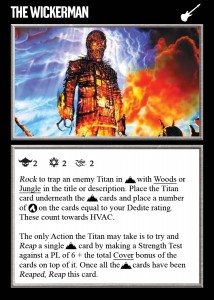 Finally, we have Sonic Wizardry Cards. In the universe of BoHM, sub-quantum superstring manipulators can be built as a variety of instruments to produce music that literally manipulates reality.
Finally, we have Sonic Wizardry Cards. In the universe of BoHM, sub-quantum superstring manipulators can be built as a variety of instruments to produce music that literally manipulates reality.
Certain Titans are built with giant Harmonic Resonators (the core of a superstring manipulator) inside them, moleculer speaker arrays in their surface and a special instrumental interface in the cockpit to allow the Rider to bend reality from inside the machine. To the outside observer, it looks for all the world like the Titan is playing air guitar, or miming the play of some other instrument.
In Titans, Sonic Wizardry cards are basically science-magic and can do some fairly awesome things if you have the right styles at the right ratings. The card above, for instance, is in Eddie’s TAC Deck.
NOW TO CREATE THE ACTUAL DECKS
Now that I have the prototype bases done, I am moving into InDesign and designing the card sheets for the demo set. There will be at least 4 Titans and 4 Riders with 4 unique decks, but if I can, I want six ready for demoing at Cometcon at the end of March. But I also have about 180 cards to create for the next revision of QBB, so we’ll see what happens.
Any comments on what you’ve seen, questions on how the game might play out or suggestions for cool heavy metal inspired cards? Head over to my forums and let me know what you think…
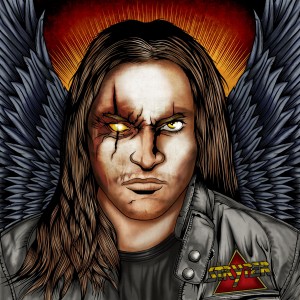 The final deck for my demo set is complete: Rex Sweet, Nazarite Priest in his Juggernaut class 4RC-H4NG3L ‘Archangel.’
The final deck for my demo set is complete: Rex Sweet, Nazarite Priest in his Juggernaut class 4RC-H4NG3L ‘Archangel.’
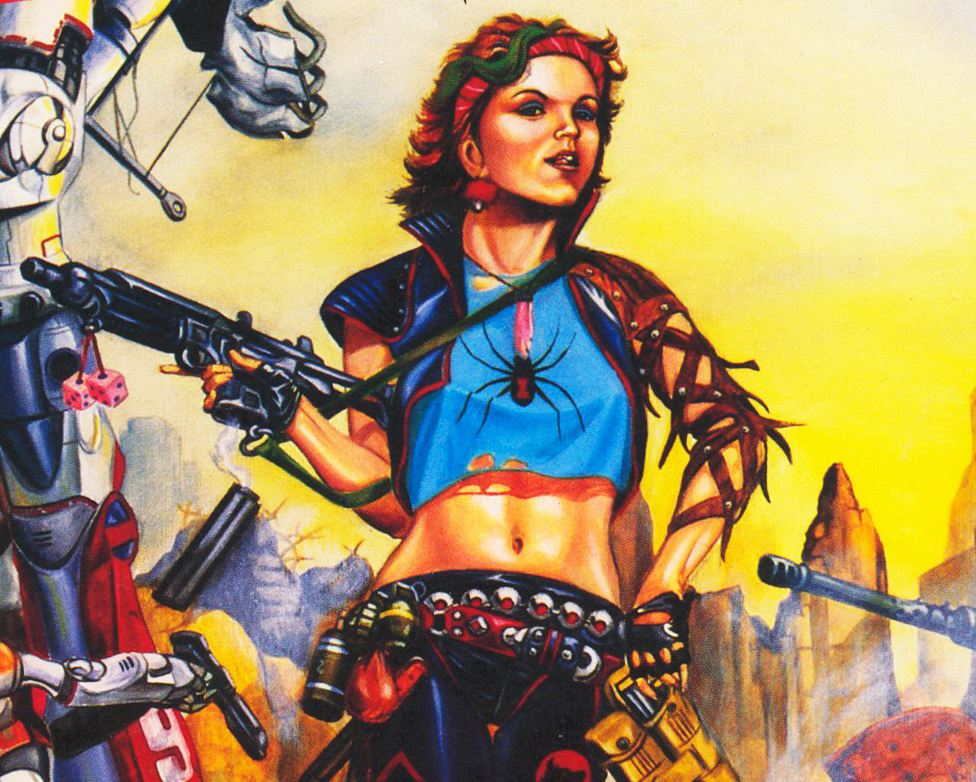
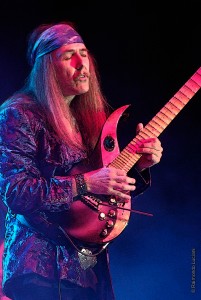
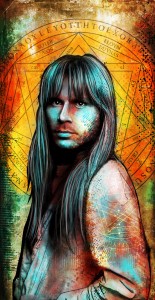



 are the main ways you utilize cards in the game and should be familiar to those who have played similar games before).
are the main ways you utilize cards in the game and should be familiar to those who have played similar games before). Terrain Cards represent the surface features of the battlefield and how it affects the combatants.
Terrain Cards represent the surface features of the battlefield and how it affects the combatants. Fame, to Ready into play, representing the scarcity of resources and the fact that only the most famous metalheads will have access to the choicest support units, like the F-Bomb or the Valkyries (seen at right).
Fame, to Ready into play, representing the scarcity of resources and the fact that only the most famous metalheads will have access to the choicest support units, like the F-Bomb or the Valkyries (seen at right). Tactical Cards (indicated by the barricade icon in the top right) represent certain advantages that might present themselves during the course of battle, like an opportunity to push an enemy of the side of a cliff, or special tactics a rider might regularly use, like powering down to hide their Titan.
Tactical Cards (indicated by the barricade icon in the top right) represent certain advantages that might present themselves during the course of battle, like an opportunity to push an enemy of the side of a cliff, or special tactics a rider might regularly use, like powering down to hide their Titan.
 A sub-type of Strategic card is the Leader (represented by the skull icon wearing an officer hat). These cards represent special personalities in your Warzone that you might have influence with. If you have the ear of a Leader, they can use their influence to provide everyone on your side of the battle with long term enhancements.
A sub-type of Strategic card is the Leader (represented by the skull icon wearing an officer hat). These cards represent special personalities in your Warzone that you might have influence with. If you have the ear of a Leader, they can use their influence to provide everyone on your side of the battle with long term enhancements.



